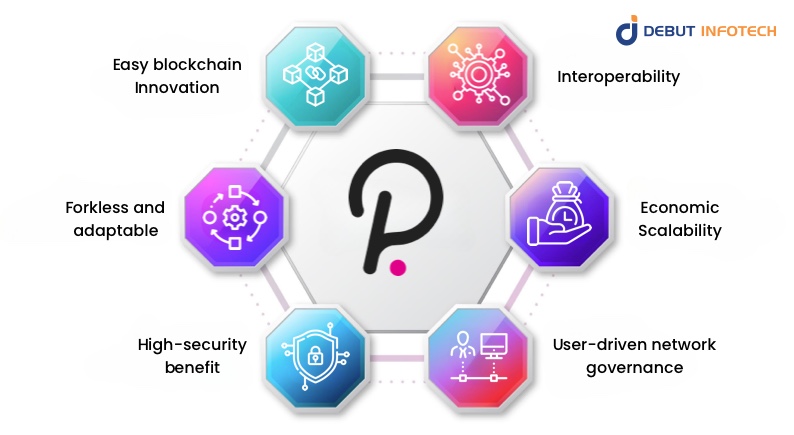Table of Contents
Home / Blog / NFT Marketplace
A Comprehensive Guide to NFT Marketplace Development on Polkadot
January 19, 2024

January 19, 2024
The NFT market is expanding rapidly, and practically all blockchains promote the formation of NFT marketplaces within their ecosystems. Cross-chain interoperability in NFTs becomes essential because these markets operate on many blockchain networks. NFTs’ value and trading are restricted to a single marketplace if they are not interoperable. One of the main issues impeding NFT adoption worldwide is a lack of compatibility within NFT marketplaces. As a result, NFT traders search for a marketplace where they can interact with every NFT project.
Polkadot recognizes these commitments and offers its users a network protocol that permits the sharing of any kind of data, including resources and tokens. The Polkadot NFT marketplace is compatible with multiple blockchain networks. It makes it easier to mint compatible NFTs, enabling traders to transact tokenized copies of their assets internationally. As the need for cross-chain NFT marketplaces grows, let’s learn more about Polkadot and how to create NFT marketplace on Polkadot.
All About The Polkadot Network

As a completely decentralized blockchain, Polkadot allows for genuine interoperability between many Parachains and external chains connected by bridges. By joining the Polkadot network, users may create solutions that effortlessly connect with different blockchains to take advantage of cross-blockchain data sharing and transfer—not just tokens—of all kinds. The Web3 Foundation, a Swiss group that seeks to create an open-source, decentralized web free from central control, supports the Polkadot project.
Developers can use the substrate network in Polkadot to create Parachains. There is an inherent interoperability among the Parachains constructed over the Polkadot Relay chain. In this sense, whether the Parachains are permissioned, permissionless, or consortia, the Polkadot network facilitates smooth communication between them. While most first-generation blockchains are not cross-chain compatible, NFT marketplaces built on Polkadot Parachains are. Their NFTs are improved by interoperability, which makes trading on several markets possible.
By enabling individuals to create creative solutions, Polkadot seeks to liberate developers from depending on a frayed web where participating institutions may misuse their privileges and betray a confidence.
What is an NFT Marketplace?
Buyers and sellers of NFTs can interact on the decentralized virtual NFT Marketplace to mint, purchase, sell, and exchange NFTs. Both tokenized versions of real-world and digital assets are available via these platforms. Users can buy and sell NFTs on the marketplaces using credit/debit cards and cryptocurrencies. These decentralized marketplaces let users trade NFTs and hold auctions where the highest bidder can purchase any NFT they choose.
NFT developers include those who create digital material, artists, influencers on social media, luxury companies, gamers, collectors of video games, and even well-known celebrities who utilize NFTs as a branding tool. These markets provide NFT developers with an excellent way to earn money from their creations. Audiences can engage with their preferred artists on this platform and claim ownership of the NFTs they want. NFT buyers can demonstrate their ownership of NFTs even in cases where those NFTs are traded on the secondary market because NFTs provide unchangeable proof of ownership. After ownership is transferred, NFTs continue to pay royalties to the original owner. These advantages have led to the global adoption of NFT marketplaces.
Why Should You Consider NFT Marketplace Development on Polkadot?

Although blockchain is fundamentally decentralized, it cannot interact with other blockchains located on other chains. Similarly, NFT markets constructed on separate blockchain ecosystems cannot permit their NFT traders to visit or examine the NFTs on another NFT marketplace based on a different blockchain. To overcome these interoperability difficulties, Polkadot offers a comprehensive decentralized web where anyone can establish an interoperable NFT marketplace development without needing intermediaries who can access the users’ data or interrupt communication across blockchains. The following are Polkadot’s distinctive qualities:
Easy blockchain Innovation
Polkadot’s Substrate framework enables users to quickly construct custom blockchain solutions, NFT marketplaces, and other blockchain-based use cases. To start enjoying interoperability and security immediately, you must connect your chain to the network. Such ease of creation contributes to Polkadot’s ongoing growth.
Forkless and adaptable
Hard forks are unnecessary for the Polkadot network to implement updates incorporating functionality or correct issues. This feature allows the protocol to quickly adjust to changes and evolve into a more sophisticated blockchain environment.
High-security benefit
Chains can interact meaningfully thanks to Polkadot’s unique data validity mechanism and availability. As a result, the chains maintain their independence while sharing security.
Interoperability
Users on Polkadot can move any data or resource—not just tokens—across chains. Interaction between the different Parachains connected to the Polkadot network is made possible by Polkadot.
Economic Scalability
Polkadot offers remarkable economic scalability since it appoints a shared pool of validators to validate and secure many blockchains. Polkadot offers transactional scalability by distributing transactions among these several blockchains.
User-driven network governance
With input from all stakeholders, Polkadot provides an advanced governance framework. On-chain coordination and autonomous execution are used for Polkadot network upgrades.
Step-by-Step Guide on How to Develop NFT Marketplace on Polkadot?
This section will walk through the step-by-step process of developing and launching an NFT marketplace on Polkadot. For this, you must first install the sample marketplace locally on a computer or a virtual machine with Ubuntu OS. In addition, you need to set up the infrastructure (like domain name, firewall, hosting, Nginx, and SSL certificate) that allows users to access the server hosting the NFT marketplace development. Let’s proceed to the marketplace development.
The following are the system requirements for developing a Polkadot NFT marketplace:
- OS: Ubuntu 18.04 or 20.4
- docker CE 20.10 or up
- git
- docker-compose 1.25 or up
- Google Chrome Browser
Step1- Install Polkadot (.js) Extension
Visit https://polkadot.js.org/extension/ and click on the ‘download for Chrome’ option. You can follow the remaining instructions, which are self-explanatory, using Chrome.
Step2- Create admin address
After that, click the Polkadot{.js} extension icon and choose ‘establish a new account’ from the menu. It is necessary that you write down a 12-word memory seed and keep it in a secure place. Keep this phrase to yourself because it is the only thing needed to access the deposited funds and your NFTs on the marketplace. To finish setting up your account, refer to Polkadot{.js} for additional instructions.
Step 3- Get DOT
You’ll need some DOT, the native coin of the Polkadot platform, to regulate it. On the TestNet 2.0, however, using the marketplace is free. Proceed to the Polkadot (.js) extension, copy your account address, and submit it to the faucet bot to obtain your coins.
Step4- Deploy the smart contract for the marketplace
- Download the metadata.json and Matcher. Wasm files first.
- Next, navigate to the Contracts page and launch Polkadot Apps UI.
- After you have received the matcher, wasm and metadata.json files, click the “Upload & deploy” code button. Click “Next” once the files have been chosen.
- Donate 300 coins to the contract since the data storage mechanism needs funds.
- A green notification will appear in the upper right corner of the screen once your transaction has been appropriately completed. Additionally, the contract will appear in the “contacts.”
- Look for the “SetAdmin” method by expanding the messages section.
- Select the “exec” button that appears in front of the setadmin. Next, choose the marketplace address as the parameter (message to send) and the caller (call from the account).
- Click the execute button, enter the exact address twice, and complete the remaining steps of the signing procedure.
- Copy the address of the Matcher contract after clicking on it to use it later.
- Your matcher contract is now ready to be used.
Step5- Clone the marketplace code on GitHub
Open the terminal and run the following command:
git clone https://github.com/[samplemarketplace]/marketplace-docker
cd marketplace-docker
git checkout feature/easy_start
git submodule update –init –recursive –remote
Step6- Configure backend (.env file)
Use your administrator address, seed, and matcher contract address to configure the marketplace backend. Adhere to the instructions provided:
- In the marketplace docker project, create a.env file. Insert the code that follows there:
POSTGRES_DB=marketplace_db
POSTGRES_USER=marketplace
POSTGRES_PASSWORD=12345
ADMIN_SEED=
MATCHER_CONTRACT_ADDRESS=
[SAMPLE MARKETPLACE]_WS_ENDPOINT=wss://[testurl]
COMMISSION=10
DISABLE_SECURITY=true
- Modify the.env file: Change ADMIN-SEED to the admin mnemonic seed phrase (12 words) you previously saved while setting up the admin address in the Polkadot (.js) application.
- After the app is deployed, change the value of MATCHER_CONTRACT_ADDRESS to the Matcher contract address you previously copied from the Apps UI.
- The remaining values will not change.
Step 7: Frontend configuration (.env file)
Now, we will configure the front end of the marketplace with your matcher contract address and administrator. Choose the domain name hosted on the localhost and specify the collection you wish to have on the market (to give an example).
1. Use the UI/apps/packages to create an empty.env file, then copy the following code there:
CAN_ADD_COLLECTIONS=false
CAN_CREATE_COLLECTION=false
CAN_CREATE_TOKEN=false
CAN_EDIT_COLLECTION=false
CAN_EDIT_TOKEN=false
COMMISSION=10
CONTRACT_ADDRESS=”
DECIMALS=6
ESCROW_ADDRESS=”
FAVICON_PATH=’favicons/marketplace’
KUSAMA_DECIMALS=12
MAX_GAS=1000000000000
MIN_PRICE=0.000001
MIN_TED_COLLECTION=1
QUOTE_ID=2
SHOW_MARKET_ACTIONS=true
VALUE=0
VAULT_ADDRESS=””
WALLET_MODE=false
WHITE_LABEL_URL=’http://localhost’
[SAMPLE MARKETPLACE]_COLLECTION_IDS=23,25
[SAMPLE MARKETPLACE]_API=’http://localhost:5000′
[SAMPLE MARKETPLACE]_SUBSTRATE_API=’wss://testnet2.[testurl]’
Step 8- Build and Run
You can pre-pull the docker images before starting.
docker pull postgres:13.4
docker pull node:latest
docker pull ubuntu:18.04
Run the following command in the terminal and give it some time to complete:
docker-compose -f docker-compose-local.yml up -d –build
Step 9. Finish
Open localhost in your Chrome browser. Upon the first launch, you will see the request for website authorization from Polkadot{.js}. Select “yes.” Now that your marketplace is connected to the blockchain ecosystem, the Marketplace page will remain blank. It’s now prepared for use.
Conclusion: Create an NFT Marketplace on Polkadot With Debut Infotech
Our team of blockchain-passionate developers at Debut Infotech is dedicated to creating reliable and cutting-edge blockchain solutions and NFT marketplace development. We provide end-to-end development services, from Parachain development to full-stack NFT marketplace development, if you’d like to build your own NFT marketplace on Polkadot. Our staff is knowledgeable about the SDKs, tools, frameworks, native programming languages, and other components of the Polkadot ecosystem.
Get in touch with our Polkadot blockchain developers if you’re interested in starting your own decentralized NFT marketplace.
Frequently Asked Questions
Q. Does Polkadot Support NFT?
A. There are many ways to interact with NFTs. A FRAME palette is now available on the Westmint testnet and Polkadot Asset Hub. The pallet includes a new method for configuring collections, items, and NFTs.
Q. What do you need for an NFT marketplace?
A. You will need a cryptocurrency wallet to store and exchange your best NFT tokens for an NFT marketplace. Users must register and upload digital artwork before selling their creations on the market.
Q. What blockchains does Polkadot support?
A. Polkadot unites a network of heterogeneous blockchains called parachains and parathreads. These chains connect to and are secured by the Polkadot Relay Chain. They can also connect with external networks via bridges.
Talk With Our Expert
Our Latest Insights
USA
2102 Linden LN, Palatine, IL 60067
+1-703-537-5009
[email protected]
UK
Debut Infotech Pvt Ltd
7 Pound Close, Yarnton, Oxfordshire, OX51QG
+44-770-304-0079
[email protected]
Canada
Debut Infotech Pvt Ltd
326 Parkvale Drive, Kitchener, ON N2R1Y7
+1-703-537-5009
[email protected]
INDIA
Debut Infotech Pvt Ltd
C-204, Ground floor, Industrial Area Phase 8B, Mohali, PB 160055
9888402396
[email protected]




Leave a Comment